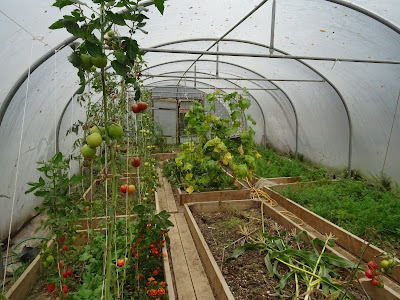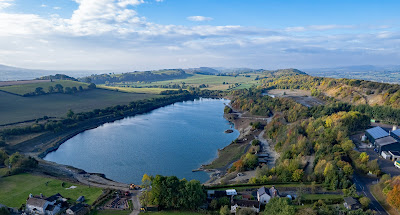Wednesday 5th October 2022, Llwynderw
For this outing we travelled into Wales to the farm at Llwynderw just west of Llanidloes along the Severn valley. The owner comes along to meetings of the group and this week we took the opportunity to visit his farm.
Unfortunately the rain tried its best to disrupt the trip although it did relent every now and then until we finished the day in glorious warm sunshine.
Rain greeted us on arrival. But a cup of tea (or coffee) and a biscuit strengthened our resolve not to be put off doing what we had come to do.
As the rain eased we left the comfort of the farmhouse and made for a polytunnel nearby.
This was searched high and low for any signs of invertebrates. There were a few craneflies trying to escape, unsuccessfully, by bashing themselves against the polythene sheeting. Some of these were caught and examined to determine their species and were then rewarded by being released outside.
Whilst we were in the tunnel the rain came and went. The sound of it hammering against the sheeting reminded me of many days of cricket sitting in a pavilion waiting for it to stop so that we get back to the game. Or for the captains or call it off so we could go to the bar.
A pause in the rain drew us away from the shelter of the polytunnel to look at the rest of the garden, Some Common spangle galls were spotted on oak leaves. Here is a photograph of one of them.
 |
| Photograph: John Lyden |
But after a short while the rain returned and we decided it was time for lunch.
We were invited to lunch in the farmhouse. An offer that was gratefully accepted, especially as the rain soon turned into a downpour.
Needless to say as we lunched the rain stopped and the sun came out!
After lunch we set out to explore a woodland.
The rain returned but we pressed on determinedly.
After a while the rain stopped and the sun came out. It was suddenly a very pleasant warm autumnal day.
We began to dry out.
And spot things of interest:
A moth, Agonopterix arenella;
 |
| Photograph: John Lyden |
A fungus on a dead Holly leaf, Trochila ilicina, known as Holly speckle;
 |
| Photograph: John Lyden |
A Flounced chestnut moth;
 |
| Photograph: John Lyden |
And finally some curious constructions on an oak tree – leaves that had been “moulded” to form miniature nests;
 |
| Photograph: John Lyden |
This structure has been made by a weevil, Attelabus nitens, known as the Oak leaf-roller. It lays an egg close to the edge of an oak leaf then cuts and rolls the leaf to construct a nest to protect the egg.
As usual time had caught up with us and we made our way back to the farmhouse where the day was wound up with a drink and cake. Wonderful!
We travelled home in glorious sunshine in and almost cloudless sky …
Apart from the huge black cloud that seemed to follow us all the way.
Wednesday 12th October 2022, Stretton Westwood Quarry
We just about squeezed all our cars into the site car park. It was lucky that no-one else wanted to visit whilst we were there!
Material generated by the Much Wenlock Flood Alleviation scheme was used to encourage the re-growth of calcareous grassland within this former quarry. The visible effects of this scheme was the sculpting of several mounds on the quarry floor. Green hay from a suitable donor site was then strewn on the mounds to initiate the restoration of the vegetation.
There is already an area of calcareous grassland by the car park and that is where our day began.
Finds from this area included:
A Glow-worm larva;
 |
| Photograph: David Williams |
A nymph of the planthopper, Eupelix cuspidata, note that the nymph has already developed the distinctive arrow-head shaped head of the adult;
 |
| Photograph: David Williams |
And a sawfly larva whose identity, as yet, remains a mystery.
 |
| Photograph: David Williams |
Moving on from the grassland we descended to the base of the quarry and to one of the mounds.
Some of us were quite content to investigate the vegetation around the base of the mound whilst the more adventurous searched the sides and the top.
One of the group who seems quite happy to get his hands dirty whilst leaving no stone unturned was successful in finding a Smooth newt in amongst the stones.
 |
| Photograph: Neil Nash |
He was also able to find:
A Rounded snail, Discus rotundatus;
 |
| Photograph: Neil Nash |
And the larva of a Cardinal beetle.
 |
| Photograph: Neil Nash |
There were some fungi in fruit within the quarry. Here are a few that were photographed:
A Blackening waxcap, Hygrocybe conica;
 |
| Photograph: Neil Nash |
A Shaggy bracket, Inonotus hispidus;
 |
| Photograph: Neil Nash |
And a Russula which was providing a feast for the slugs.
 |
| Photograph: Ian Plumridge |
It was time for lunch which we took in some woodland.
 |
| Photograph: Ian Plumridge |
After lunch a quick scan of the woodland did not yield anything of interest. We moved on to one of the other mounds.
The climb up this mound was easier than the others and even the less mobile amongst us managed it comfortably.
A pause at the top to enjoy the view.
Searching the damper vegetation at the base of this mound uncovered an inconspicuous ladybird, Scymus haemorrhoidales.
 |
| Photograph: David Williams |
Moving on from this mound we took a look at the lime kiln that bordered the Much Wenlock – Church Stretton road, scoured the vegetation under a hazel for nibbled nuts – several were found, but none that indicated a dormouse - then started our the meander back to the cars.
On the way we found another inconspicuous ladybird, Nephus redtenbacheri;
 |
| Photograph: David Williams |
And a Field grasshopper.
 |
| Photograph: David Williams |
Eventually we took the slope back up to the car park, said our goodbyes and went home.
A Bonus …
Whilst at the peak of the very long tripod to take the first photograph of this report, the opportunity was taken to turn the camera around and capture an image of Lea Quarry South and the land beyond framed by Wenlock Edge on the right and hills to the left.
And that concludes the Joy of Wildlife programme for 2022.
But we have not stopped making our weekly visits. We have switched into “Winter mode”. There is no pre-planned programme but trips will continue to be arranged for those who are interested. Invitations to each visit will be issued in the normal way.
My thanks to the owners of Llwynderw for inviting us to visit their farm and providing excellent refreshments and refuge when needed. Thank you to the National Trust for permitting us to visit the quarry. My gratitude to the photographers for providing their excellent images that supplement my efforts.
Finally, thank you to everyone who has taken to time and trouble to read these scribblings over the last few moths.




.JPG)













.jpg)
































